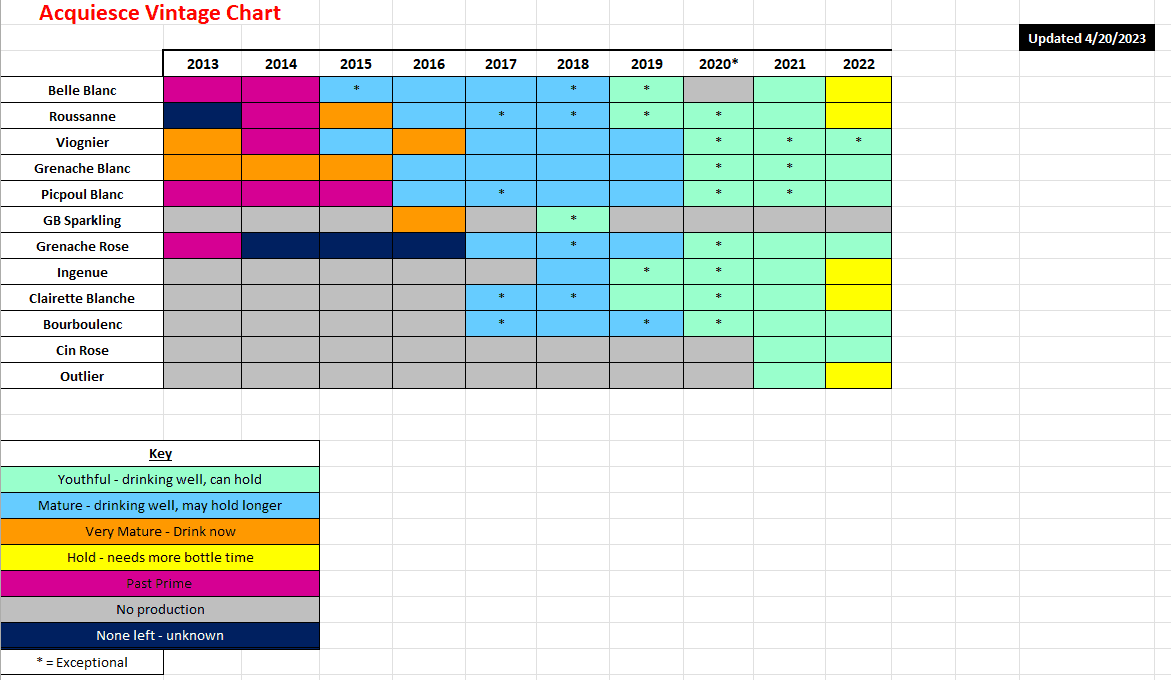


I recently completed our Acquiesce vintage chart. I started this chart with the goal of finishing it in a month or 2, not realizing that we have library wines going back to 2013 which made the task greater than expected. The combination of higher priority projects and the sheer number of wines I had to get through, it ended up taking me about a year to complete. After a sigh of relief, I thought this would be a good opportunity to talk about how our wines develop over time. I’d like to preface by saying that this information is generalized and based on typicality, as we know, there are exceptions to every rule.
In the tasting room, we often get asked how long our wines can lay down for. The answer is usually “it depends”. Ok….it depends on what? For a little bit of perspective, let’s look at red wines first. Thinking of reds that can age for decades, Cab comes to mind immediately. Some producers don’t bottle Cab without 18-24 months of barrel time, then release it after it has spent at least year in bottle. For reference, I just popped on Opus One’s website and their current release is 2019. So, why can these age for so long? Simply put, because of structure. Acid and tannins (phenolics) give Cab the framework for longevity. As a high tannin grape, Cab needs some time to soften up before they are approachable. Which is why Opus One waited 4 years before release. This won’t allow them to age forever, but I’d generalize and say 50 years before you really start to notice them drop off. Port is one exception, but it has fortification on its side.
White wines don’t have the tannin back bone that reds do. Red wines are fermented on skins which is the basis for tannin extraction, where white wines are fermented as juice and skins are discarded. Additionally, white grapes have inherently less tannin than red grapes. Looking back at structural components for aging, we’re left with acid. Think of a German Riesling, Hunter Valley Semillon, or Burgundian Chardonnay where acid is key to ageability. Riesling is a high acid grape, and we see these age for decades. On top of that, it’s an aromatic grape that is often given some skin contact time to extract aromas but also grabs some phenolics in the process. Heat and alcohol are responsible for extraction in red and amber wines, but because the skin contact strategy in this instance would be pre-fermentation, extraction is minimal. You do get a form of tannin from oak aging. These are called hydrolysable tannins, which break down in acidic solutions such as wine, but they aren’t the major factor in ageability.
So, what about Rhône whites? Roussanne is a variety that can age for 10 years single handedly. It’s lower on the acid spectrum, but innately more phenolic than any other white Rhône grape. If you’ve ever had a young Roussanne, you may have noticed that it can have a little bitter bite on the finish. That’s its phenolic structure at work. Roussanne is a crazy grape in general. Those who grow and produce Roussanne know it as the “princess grape”. Difficult to grow yet can age very well and may go through an “oxidative state” where it falls flat then rebounds with more age. To give it even more longevity, blending is our friend. The white blend from Château de Beaucastel consists mostly of Roussanne, but is blended with Grenache Blanc, Bourboulenc, Clairette Blanche, and Picardan. The addition of higher acid varieties gives Roussanne the boost it needs to combat time. Their 2010 blend can “age brilliantly for decades” according to one critic.
Where does Acquiesce fall here? While we don’t have stock going back to 2010, we’re pleased with what we’ve seen in our older wines. Roussanne, Viognier, and Grenache Blanc were the only varieties Sue had until 2015, so we’re still finding out how the others fair. That will be an ongoing learning process, but we’re generally seeing our Belle Blanc and Roussanne age the best, falling in line with Beaucastel examples. Our first Ingenue wasn’t until 2018 and we’re excited to see that with more age. There’s also been some production improvements as Acquiesce grew, including a better closure and better bottling truck, that give us even more confidence that our wines can go the distance. At the end of the day, we want to make wines that give you the choice to drink young or with some evolution; It all depends on your preference. If you like our wines young, fresh, and vibrant, I recommend drinking them in the first 2 years. If you like to see a little bit of evolution and changing of flavor profiles, wait 3-5 years. If you like more mature wines, our 2015 Belle Blanc has 8 years under its belt this year and looks stunning. Moral of the story here is to drink what you like 😊
For your viewing pleasure: below see baby blue eyes peeking through our cover crop